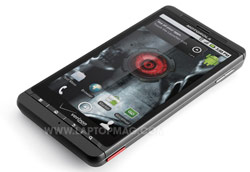Hands-on: Froyo Update Makes Motorola Droid X Slightly Sweeter

Our favorite smart phone for Verizon Wireless just got better. The question is how much better? On Wednesday Android 2.2 (Froyo) came to the Droid X, offering faster CPU performance, Flash Player 10.1, and small improvements to the mobile hotspot app. You also get Exchange support and Visual Voice Mail.
Other enhancements include the ability to let users to manage message history from the Contacts application, to edit MMS messages after attaching video files, and to manage contacts with the updated Backup Assistant.
To see how much of a different Froyo makes, we downloaded the software update manually to our tester Droid X and took it for a spin.
The first thing we noticed with the Android 2.2 was a new lock screen. Instead of the green lock that you slide across the screen, you’ve got a gray, almost chrome color for the lock and silencer. It doesn’t do a lot, but it signifies to the user that they are using Froyo. While we noticed a slight delay when unlocking the phone, it didn't stutter quite as much as before. We also like the sleeker looling Battery Manager. Sadly, the manager force closed the first few times we tried to use it, but after that it worked fine.
On the plus side, Froyo dramatically improves CPU performance, according to the Linpack and Benchmark apps from the Android Marketplace. The Droid X’s frames per second for 2D and 3D performance were basically unchanged. Oddly, the graphics, memory, and file system performance numbers were slightly down, according to the FPS2D and NenaMark1 benchmark apps. The unchanged and slightly lower numbers might explain why the upgrade didn’t make a noticeable improvement for casual use, whether we were swiping across home screens or browsing through settings.
Here's a look at how the Droid X with Froyo compares with other Android phones running 2.2.
| Benchmark Tests | Motorola Droid 2 (Android 2.2) | HTC Evo 4G (Android 2.2) | Motorola Droid X (Android 2.1) | Motorola Droid X (Android 2.2) |
| Row 1 - Cell 0 | Row 1 - Cell 1 | Row 1 - Cell 2 | Row 1 - Cell 3 | Row 1 - Cell 4 |
| FPS2D (2D FPS) | 61 | 30 | 58 | 59 |
| Linpack for Android (MFLOPS) | 13.87 | 33.8 | 8.19 | 14.407 |
| Nbench | Row 4 - Cell 1 | Row 4 - Cell 2 | Row 4 - Cell 3 | Row 4 - Cell 4 |
| >Memory | 2.93 | 2.544 | 2.911 | 2.941 |
| >Integer | 4 | 3.959 | 3.992 | 3.985 |
| >Float | 0.78 | 0.912 | 0.78 | 0.779 |
| Benchmark | Row 8 - Cell 1 | Row 8 - Cell 2 | Row 8 - Cell 3 | Row 8 - Cell 4 |
| >Graphics | 30.7 | 26.78 | 31.487 | 31.473 |
| >CPU | 1706.4 | 1880.69 | 777.93 | 1460.04 |
| >Memory | 409.1 | 293.62 | 424.25 | 354.31 |
| >Filesystem | 107.3 | 78.99 | 162.21 | 160.39 |
| NenaMark1 (3D FPS) | 22 | 13.3 | 22.6 | 21.7 |
We also took the mobile hotspot feature for a spin to see if there was any improvement. We connected to Verizon's 3G network using laptop, but did not see much difference in speeds from Speedtest.net. The download speed was slightly slower, while the upload and ping times were slightly higher. Of course, the time of day and proximity of other users nearby using data could have affected the data speeds as well.
Stay in the know with Laptop Mag
Get our in-depth reviews, helpful tips, great deals, and the biggest news stories delivered to your inbox.
With Flash Player 10.1 now enabled in the stock Android Web browser, you can now access all sorts of content that you couldn't see before. On TNT.tv, for example, we were able to watch full episodes of shows that looked great on the screen (especially over Wi-Fi). Flash video on NYTimes.com looked OK but not spectacular. Mobile flash games on kongregate.com worked well. The trade-off is that all sorts of Flash ads work while you browse normal sites, which can sometimes slow down the browsing experience.
Overall, we will happily eat the Froyo Google is serving on any Android phone that can handle it, especially on a great device like the Droid X. While the Droid X doesn’t become a dramatically different device with this upgrade, it lets you do things you previously couldn’t, speeds up the CPU, and adds a few other tweaks that puts this superphone back on the same pedestal as the Evo 4G.
